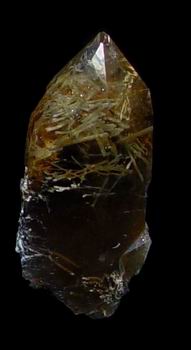With the discovery of pocket 9 close on the heels of 8, Mary
was beginning to feel a little left out of the proceedings as she continued
to hold down the revenue generating side of the operation in Florida. Richard
and I decided that it would be best to focus on the task of schist removal
in the remaining 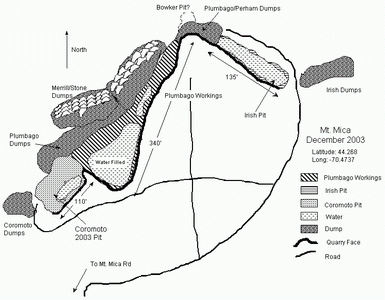 10
days before her next visit to Mt. Mica. To me, even the schist removal
is an interesting chore. In fact, I believe this is a necessary attribute
for successful pegmatite mining as it seems, at least in Maine, to be a
substantial portion of the job. Pegmatites just seem to show a little ankle...the
rest is modestly concealed by overburden. So for the next week or
so we daily drilled holes up to 13' deep , blasted and hauled away the
muck. By the time Mary arrived, we had removed almost all of the schist
up to the western edge of the Plumbago workings. Click on the map for a
more detailed view. 10
days before her next visit to Mt. Mica. To me, even the schist removal
is an interesting chore. In fact, I believe this is a necessary attribute
for successful pegmatite mining as it seems, at least in Maine, to be a
substantial portion of the job. Pegmatites just seem to show a little ankle...the
rest is modestly concealed by overburden. So for the next week or
so we daily drilled holes up to 13' deep , blasted and hauled away the
muck. By the time Mary arrived, we had removed almost all of the schist
up to the western edge of the Plumbago workings. Click on the map for a
more detailed view.
Once Mary was on the scene we began benching back the newly exposed
pegmatite. As fate would have it this effort did not expose more than a
few small vugs with some paltry quartz crystals. Mary spent quite a bit
of time in pocket 9 making sure we had recovered every last grain of interest.
Her digging produced about a dozen tabular quartz crystals that were ensconced
behind some mica books in 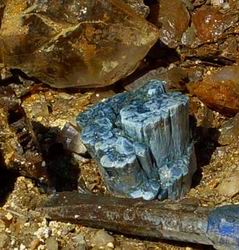 the
rear of the pocket. Essentially though she left empty handed. However,
she left us with instructions to mine behind and to either side of pocket
9 as a first priority. Sure enough, we found pocket 10 just to the left
of 9 and slightly behind it. Perhaps a case could be made they were all
one pocket. the
rear of the pocket. Essentially though she left empty handed. However,
she left us with instructions to mine behind and to either side of pocket
9 as a first priority. Sure enough, we found pocket 10 just to the left
of 9 and slightly behind it. Perhaps a case could be made they were all
one pocket.
Pocket 10, unlike 9, was to produce some more fluor-apatite crystals.
In fact, 10 yielded an apatite that looked more like a coral than apatite.
Richard immediately dubbed it 'dog bone' . The crystal is 15 cm long...fair
size for an apatite. The crystal at one point had been attached to a mica
book about midway along the 'prism' face of the crystal. Interestingly,
the attachment points are more purple, like the typical Maine purple fluorapatite.
Here Richard poses in front of Pocket 10. Pocket 9 is visible to
the right.

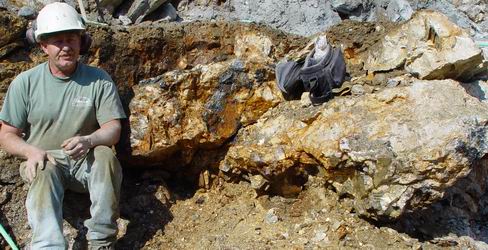
Richard at pocket 10 September 23, 2003

View of the Mt. Mica Coromoto workings before the discovery of
pockets 8-11.
Plumbago western workings are visible in the background.
Once 10 had been substantially cleaned out
, we resummed benching along the eastern face of our workings and along
the down dip southern face. The southern face below the plunge the pegmatite
seems to be thinner at 5-6'. We have worked nearly 75' along this edge
and we have yet to find anything larger than fists sized vugs in quartz.
The pegmatite has all of the mineral constituents exhibited by the up dip
side including abundant cleavelandite surrounding the small quartz pods
but it fails to coalesce into a significant cavity. On the other
hand, the central portion of the eastern face had been showing promise
for the past several benches. It was gradually becoming more mineralized.
The garnet 
line and cleavelandite were thickening and becoming surrounded by
large mica books. Pendant schorls were radiating from the upper contact 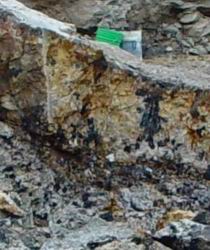
but the pegmatite had yet to produce a significant pocket. On Ocotober
2 this all changed when our blasting exposed numerous loose mica books.
Following the mica trail back towards the working face we found an area
of loose cleavelandite. Carefully washing through this material, we started
to find large massses of cookeite. Imbedded in this cookeite were numerous
very glassy and clear quartz crystals. Most were incrusted in cookeite
and many incorporated this materiall within the prisms and terminations
of the crystals. All of the loose cookeite was placed on a screen to be
washed. I would dig it out by the handfuls and Richard would carefully
examine it on the screen. In a small chamber we found 30 or more small
completely encrusted crystals. These turned out to be fluorapatites
with the carbano coating. The coating could be easily flaked off reveling
green-blue apatite crystals beneath. We spent the better part of the daycombing
through this loose material . Once we had cleaned in front
of the face and retrieved as much as we could, we turned our attention
to the face itself. We use a garden hose connected to our 2" gasoline pump
and with it we are able to ' hydrauliclly ' mine as the jet from the hose
exposes any soft areas in the rock. In such a manner we soon exposed
two cavities in the face that then merged to form one large cavity.
From the roof of this cavity large quartz crystals hung termination
down and almost touched the floor. This cavity, like the small chamber
is front, was filled with cookeite and contained significant masses of
kaolin as well. We would use our hose to washe out the kaloin and
then pickup the loosened quartz crystals. While washing up into the roof
of the chamber in an area we could not see, suddenly a mass of blue apatite
fell from the roof and thudded audibly into the kaolin and mica below.
Richard and I both were amazed. The group was slightly smaller than a 1/2
of a soda can and had landed terminations down. Looking carefully
in the back of the pocket we could see more apatite groups lying amongst
a profusion of loose mica.
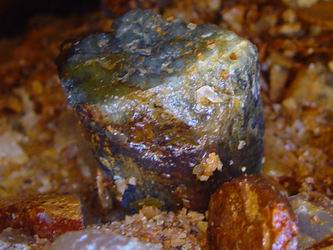
The 'soda can' as it landed on the floor |
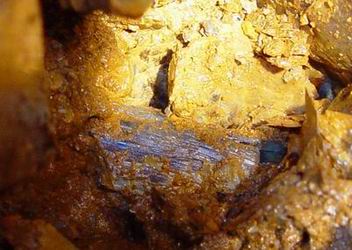
Apatites mixed amongst decomposed mica |
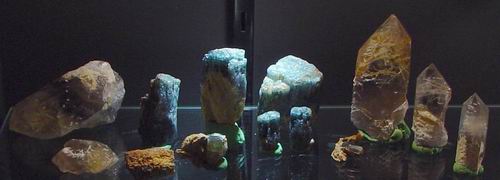
Some of the crystals from pocket 11
|
